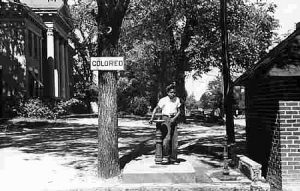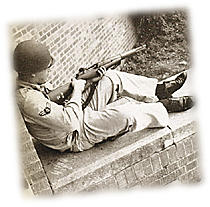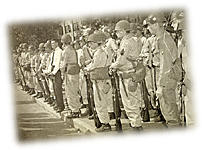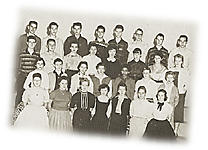We Shall Overcome
The Difficulties of School Desegregation
In 1951, Oliver Brown attempted to enroll his African American daughter into an all-white public school in Topeka, Kansas so that she could receive a good education. Brown believed that his daughter had the right to receive the same education as white children. The United States Constitution declares that all men are created equal. Why, then, was Linda Brown prevented from attending a public school? In theory, the United States guarantees equal facilities for all people, but truthfully, in the 1950s blacks and whites did not receive equal opportunities. Blacks and whites led separate lives and had unequal, separate public facilities. Many states did not allow blacks to gain equality, but rather, treated them as inferiors through segregated public facilities. The “Brown v. Board of Education” decision allowed students like Linda Brown to legally enter all-white schools. The decision required schools to become integrated. The process of school desegregation proved to be difficult because racial segregation had become a common way of life that many white Americans were unwilling to give up.
Linda Brown was unfairly rejected from attending a school simply because of her skin color. Her father, Oliver Brown, went to the head of the National Association for the Advancement of Colored People to demand his rights, and the NAACP went to court for him and all other black citizens to fight for equal opportunity in education. The NAACP argued that all-black public schools gave black children the impression that they were inferior to white children, especially since their facilities were not comparable to whites. As Dr. Hugh W. Speer declared:
If the colored children are denied the experience in school of associating with white children, who represent 90 percent of our national society in which these colored children must live, then the colored child’s curriculum is being greatly curtailed. The Topeka curriculum or any school curriculum cannot be equal under segregation (Brown v. Board of Education).
The NAACP believed the term “separate, but equal” was anything but equal, producing grossly unfair opportunities for African Americans. Yet, Topeka’s Board of Education believed that separate facilities were wholly equal since intelligent and successful black leaders such as Frederick Douglass and Booker T. Washington had emerged from all-black schools. Ultimately, Chief Justice Earl Warren claimed that separate facilities were not legal, and the NAACP was victorious because of the following statement:
We come then to the question presented: Does segregation of children in public schools solely based on the basis of race, even though the physical facilities, and other “tangible” factors may be equal, deprive the children of the minority group of equal educational opportunities? We believe that is does (Rothenberg 430)

A young African American boy using a water fountain only to be used by those that are “colored”
Since the Brown decision declared that it was unlawful for states to have segregated public schools, all school districts were expected to integrate. Yet, the Supreme Court’s “Brown versus Board of Education” decision did not require integration of schools by any set time. On May 24, 1955, “The school board votes unanimously to adopt superintendent Virgil Blossom’s plan of gradual integration that would start in September, 1957 at the high school level and add the lower grades over the next six years” (History of the Little Rock Public Schools Desegregation). It was not until several years later that schools actually followed through with integration because many Southern states prohibited their citizens from participating in such efforts. As historian John Dittmer writes, “With ‘Brown versus Board of Education’ the tranquility of the Eisenhower years would vanish overnight, plunging Mississippi [and other Southern states] into a period of violent interracial conflict unmatched since the bloody years of the 1870’s” (Dittmer 34). Most white Southerners did not particularly welcome desegregated schools, and it would take a long time before desegregation was considered tolerable, even in the most accepting of towns.
In 1957, Little Rock, Arkansas was known as an amiable community with good race relations. Little Rock was not considered any different than other southern communities except that the town “had been successful in establishing better race relations than almost any other southern city of comparable size”(Brown 7). Little Rock was described as “a pleasant, leisurely place of well-tended homes and green lawns where violets and jonquils bloom in spring, and chrysanthemums in autumn”(Brown 6). In The New York Times it was reported that public transportation and neighborhoods were integrated, and no acts of violence had developed. Little Rock seemed to be a picture-perfect place to integrate children, since national leaders thought it to be unlikely that violence would break out. However, despite the town’s calm biracial interaction in previous years, integrating schools proved to be a different story all together.

Little Rock, Arkansas’ Central High School
Central High School, an all-white school in Little Rock, was known for its academic excellence and the community was proud of it. Given the school’s and the town’s reputation, it was somewhat surprising that cries of hate became prominent once nine black teenagers tried to enter Central High School.
On September 4, 1957 nine black teenagers walked up the front steps of the all-white Little Rock high school, expecting to receive the same education as the white students in the state. To their surprise, the National Guard had established a wall to block the entrance of these students because Governor Orval Faubus of Arkansas decided that integration was not to be allowed. He purposely ignored the “Brown v. Board of Education” decision and felt that integrating the school would cause more harm than benefit. Governor Faubus believed that he was doing everyone a favor by prohibiting black children’s access to the school, but the Justice
Department ridiculed him later on. As Donald E. MacGuineas and Carl Eardley reported in The New York Times:
… the use of the armed force of the State of Arkansas to deny access to the school by Governor Faubus to be required to preserve peace and order, such use of the Arkansas National Guard was and is unlawful, and in violation of the rights of the Negro children under the Fourteenth Amendment as determined by this court (McGuineas 56).
White townspeople chanted in protest outside the school the first day the black teenagers attempted to attend classes. Due to the blockade, the nine students had to turn back and head home. Faubus saw the whites’ reaction as a sign of future mayhem at the school, so he considered his efforts to be lawful and fair. Ironically, Faubus had created more trouble by bringing in the National Guard than if he had done nothing at all. President Dwight Eisenhower made it clear to Faubus that the governor needed to follow the orders of the District Court, and therefore was expected to remove the National Guard from the school. Faubus ignored the President, and was then placed under injunction so that the school could continue to integrate. Eisenhower felt confident that the residents of Little Rock would continue integration without violence and would “welcome this opportunity to demonstrate that in their city and in their state proper orders of a United States court will be executed promptly and without disorder”(Eisenhower Bids Little Rock Shun School Violence 1957).

A guard on watch at Central High School during the riot
The president felt there would be no violence the day nine black students first entered Central High School. However, many white residents of Little Rock expressed fear and anger before the students were expected to return to the school. It was estimated that approximately five hundred of the two thousand white students would not attend the first day that schools were integrated because of fear and hatred that they and their parents felt towards blacks. One white Little Rock resident noted, “I’m afraid there is going to be more turmoil then there would have been if Negro children had been enrolled September 4 [like planned]” (Little Rock Fearful of Violence When School Opens Tomorrow 1957). While residents in town awaited the day that black children would enter the school, conferences were being held all around Little Rock to resist integrated schools. The Group of Patriotic Christians even had an advertisement that read:
All others who are against race mixing in our schools are urged to be present at this important rally. At this meeting we will launch a crusade against public enemy No. 1. Bring your friends to this great rally and learn what’s going on and what the answer is (Little Rock Negro Students to Seek Entry This Week 1957).
Little Rock, the town Americans thought to be the place where integration would occur smoothly, proved everyone wrong. Clearly, integration was going to be difficult because many whites were not willing to change.
On September 24, 1957, black students finally walked through Central High’s doors and promptly left after three hours and thirteen minutes. A white, shrieking audience had gathered outside the school insisting that the African Americans should not be part of a white learning environment. In The New York Times, one woman was described as follows: “tears flowed down her face, [and] her body shook in uncontrollable spasms” (Students Unhurt 18). In addition to this hysterical woman, chants such as “Two, four, six, eight, we don’t want to integrate” (1) echoed around the school. This tendency of some whites to overreact with hysteria made integration particularly difficult.
An unruly mob accumulated outside the school despite the barricades and police, and the mob eventually took over and chaos erupted. Some of the policeman surrendered and threw off their badges because they felt the same way as the rest of the crowd, and therefore felt ashamed to be enforcing peace when they wanted to resist integration as well. Some mothers walked into the school to remove their children for fear that they would get hurt by the black students, even after the black students had been removed from the premises. Once the police announced that all “the Negroes have withdrawn from the school,” (18) the mob was doubtful and demanded to have someone explore the school grounds to see for themselves. Mrs. Allen Thevenet, a mother, walked into the school with a police officer and went into every classroom so that she could declare to the mob that it was safe for their children to continue their school day (18). Clearly, narrow-minded white parents had produced chaos because they were not willing to allow racial change.
Most white parents were terribly apprehensive about integration, but the students inside the school had mixed reactions. The nine black students had been ushered out of the school during third period and they were surprised to be withdrawn so soon, for no commotion was taking place as far as they were aware. They felt they were accepted and were “treated kindly by the white students” (18). Terrence Roberts, one of the nine black students, did not experience any problems with his classmates, and expressed confusion when driven home. When the African American children were asked if they would want to go back to school, their response was “Yes. If we can come here without causing any trouble” (18). Although the black students felt that they had been treated well in Central High School, some white students clearly shared their parents’ views on integration. Some yelled “We’ll lynch them all” (18) in the hallways, while other white students cried uncontrollably. If all students shared an open mind to change and acceptance, then desegregation would have been easier, but unfortunately this was not the case, which made the situation much more problematic.
During this first week of desegregation, President Eisenhower allowed the National Guard to return to the school in preparation for the next day’s riots. Upset about the whites’ reaction to the African American students, Eisenhower decided to speak to the country in a radio and television address in which he explained why he felt the need to bring troops onto the school campus. He stated that he feared anarchy would become part of Little Rock and that the students might be in danger. He did not want to bring the troops in for any reason other than to make sure the next attempt at integration would be tranquil. The Governor did not believe the President’s action was wise, but Eisenhower managed to operate the situation more efficiently than Governor Faubus. At the start of Little Rock integration, Eisenhower had not wanted troops to come in, but he completely changed his mind about military action, which shows how difficult the entire desegregation process had become.

The National Guard standing outside Central High School
On the second day of school, the students were escorted into the school without too much difficulty, while the National Guard stood outside the building, making the school seem like an “armed camp” (Students Accept Negroes Calmly, 1). The tone inside the school was one of acceptance, but white parents were still not pleased. “This is the grimmest moment of my life,” noted one Little Rock resident and mother, “I wish I could tell you what’s inside me right now” (1). But despite these comments, people conformed to the President’s words of guidance to avoid mass chaos. Although it was clear that many white people of Arkansas were not willing to have their children go to school with African Americans, they learned to deal with their frustrations in ways other than confrontation, and once the nine students began to attend school regularly, the riots lessened.
The fact that residents no longer assembled outside the school to complain did not mean life suddenly became easy within the school walls. The film Eyes on the Prize Episode 2: Fighting Back, documents the racist attitudes that the black students had to cope with at Central High. In the film there is a scene that shows one of the nine black students in the cafeteria getting a bowl of chili while being harassed by a white male student. This black girl was fed up with her treatment, so she decided to pour the bowl of chili on the young man’s head. For this, she was suspended from school. Apparently, the segregationists of Little Rock responded to this incident by saying, “One down, eight to go” (Eyes on the Prize II). Even though the black students were now active participants in the white school, they were still shunned by whites.
In 1958, a year after integration began at Central High School, the first black student graduated peacefully. No one applauded for him when he walked up to receive his diploma, but no violence broke out either. However, instead of taking this as a sign of accomplishment, Governor Faubus felt the need to push for segregation of schools again. In August, he tried to pass a law that would close public schools so integration could not take place. Instead of allowing Faubus to follow through with this, the Supreme Court decided to continue with school opening as planned. Governor Faubus stubbornly disregarded the Supreme Court and closed three schools anyway. In Southern Business Men and Desegregation, historian Elizabeth Jacoway notes:
…in their [elite] hearts, most civic leaders believed that Orval Faubus was right; they might not come right out and openly support the Citizens Council, but they tacitly agreed with the arguments these people were making. After all, racial prejudice had flourished for over a hundred years in Arkansas, and it could not be expected to subside overnight (Jacoway, 28).
What had seemed like the end of a chaotic situation after a year of struggle, was really only the beginning. Faubus’ tenacious actions were a result of his racist views. Racism was not a feeling that people like Governor Faubus could simply ignore because it was the common way of life. However, that did not mean it was right, nor did it mean his actions were legal.
In September of 1958, because of Governor Faubus’ orders, the public high schools in Little Rock closed, leaving students searching for alternatives. The majority of the students ended up in private schools, while others simply moved out of the state. In having to deal with all of this chaos, students felt frustration, and some school board members who were fed up decided to resign. With open spots in the school board, many segregationists decided to run for office so that school integration would cease. As school board members, segregationists fired those who publicly supported integration. Finally, in the fall of 1959 the schools reopened due to a federal court decision that declared it unlawful for public schools to be closed to the public. A large majority of the white population in Little Rock was still not satisfied by the reality of integration, but instead of allowing mobs to turn chaotic as in the past, Little Rock police arrested all of those who convened outside the schools to protest on the first day. Although the school was calmer, the fact that the schools closings and riots occurred before African Americans were able to attend white public schools shows that this change in the whites’ lifestyles did not come effortlessly, but rather with extreme difficulty.
Not until 1972 were all public schools in Little Rock finally integrated. This long and tedious process of integration greatly affected the African American community. In The Children of the South, historian Margaret Anderson writes:
Desegregation involves admittance of the Negro children into the white school in compliance to the law. Integration involves the conversion of the two groups into a smooth-running organization relatively free of tensions, in which the students have good working relationships with each other (Anderson 102).
Clearly, the fact that white and black children were going to school together did not mean that the two races were willing to get along as if no harsh history had ever occurred. By integrating the schools, policy makers and African Americans hoped that interaction between the younger generations would bring racist attitudes to an end. Yet, “Even those who are dedicated to the proposition that the common good demands the end of segregation in the education cannot be unaware that if the transition produces martyrs, they will be the young children who must bear the brunt of spiritual conflict” (Ashmore 135). Not only did adults fight for equal rights, but black children were now forced to as well. Although black children were able to enter the white schools after great turmoil, this did not mean that the end of desegregation was close at hand.
For blacks, struggle in education proved to be both hopeful and disheartening. While blacks took steps forward in receiving better opportunities, it took more work than should have been necessary to gain equal access. Harvard Sitkoff writes:
By 1954, many Afro-Americans believed that the overturning of Plessy in the school cases would rapidly undermine the whole Jim Crow system. But it did not happen. ‘Colored’ and ‘White’ signs remained over drinking water fountains and rest rooms…By 1964, just two percent of the black children in the South attended integrated schools, and none at all in the two Southern counties involved in the Brown decision (Sitkoff 38).
African Americans felt bitter that acceptance did not occur overnight. White people who accepted segregation were afraid of change, and made it clear to blacks that this was the case. Because whites fought against integration, the struggle for African American equality was particularly unfair and difficult.
As demonstrated in Lynds’ Middletown, ideas of white supremacy have been passed down from parent to child through the generations. Racism could not simply end with school desegregation because white citizens continued to believe that they were superior to African Americans. Today, if white students are asked if they feel racism remains a large issue, the large majority of them conclude that it is a thing of the past. Yet, a white person, as a member of the majority, cannot say whether non-whites would agree. One white student on Dickinson College recently commented:
It is ridiculous to think that whites are best. What is your criteria? Best at what? I think there are a lot of people that say they aren’t racist because it is safest. Even if you don’t agree with it [desegregation] you still don’t say so because it’s taboo just like you wouldn’t say you don’t like homosexuals. You just don’t say anything at all (Luckner).
Students and parents no longer riot against integration, but racism is still prevalent among many Americans.

Yearbook photo from Central High School
Ending racism is not an easy procedure because it has been a large part of American history. Integrating schools was the best possible route to end segregation in the 1950s. Despite its difficulties, it was probably the only way for whites to see blacks differently. Integrating schools meant white students could see that black students are human, rather than imagining them as fundamentally different from themselves. When African Americans began to attend white schools, it was difficult for whites to understand why integration needed to take place. Integration meant giving up privilege and ignoring values that had been passed on from generation to generation. White supremacy had been taught for as long as white people could remember, which made integration in the 1950s unwelcome, but it was a necessary change, not only for blacks, but to positively influence whites.
In an interview, Melissa Merdinger, a current white Dickinson College student, said she believes that the only way to stop racism is by isolating children from their parents because racism is a learned behavior. She also commented that because this isolation is not possible, there is no way to end racism. Personally, I believe that racism can come to an end, but it will take a very long time. Because racism is learned, I think it is necessary for as much integration and knowledge on African American history to be present in young children’s lives. Media is a key factor in how people are perceived; if media is able to end stereotypes, which is probably impossible, then racist attitudes may not be as prevalent. If a parent is racist, his or her child may become racist as well, but I do not think that will fully determine what the child will believe. I have come across racist people who have tried to make me believe that white supremacy is acceptable, but when I read about ridiculous white reactions to school integration, the unfair stereotypes placed on African Americans, or the horrors of lynching, it baffles me that white people can ignore these facts and still think white is better than black.
Racism is still a problem today because of the excessive effort by the white population to keep blacks as second-rate citizens. The “separate, but equal” clause enforced an unfair way of life, and the Brown decision declared legal segregation unconstitutional. Desegregation of schools proved to be a long and arduous process because of narrow- minded white people who were unwilling to participate in worthwhile change. Whites simply did not want to give up any of their privileges. Although there is still a long road ahead for racism to come to an end, there is evidence to show that each coming generation is becoming less ignorant and more understanding of how unjust the history of segregation in America has been.
